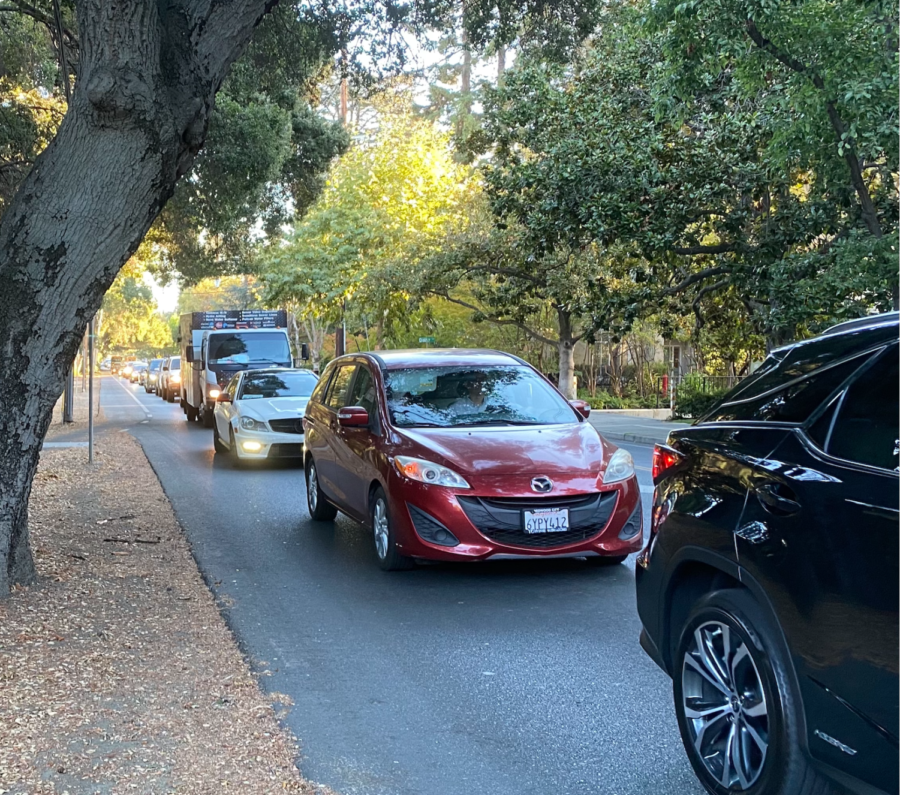Healy Pleads With Community as Menlo Faces Potential Enrollment Reduction
A line of cars waits at the intersection of University Ave. and Valparaiso Ave. at 8:14 a.m. on Thursday, September 30, 2021. Staff photo: Geoffrey Franc.
October 19, 2021
In his latest plea to reduce the number of cars coming to campus during peak hours, Head of School Than Healy reiterated incentives for meeting traffic goals, warning yet again that if these targets are not met, Menlo may have to reduce enrollment. Healy also continued to push the Go Menlo program, saying that the traffic goal was almost met the week of Oct. 4. In previous communications, he has noted that at the end of October, the school will “evaluate whether a more enforced approach is required” to mitigate this issue.
While Menlo’s Chief Financial Officer Bill Silver believes that the Menlo community “will step up and meet the challenge,” he also noted that the “enforced approach” mentioned in Healy’s latest email could possibly mean entry prohibitions. “I think the simplest thing to do is obviously to simply prevent people from driving onto the campus,” Silver said. He specified that this could entail remote dropoff locations and parking lots. However, he also noted that it’s Healy’s decision.
“The simplest thing is for people just to carpool,” Silver said. “We always met our goal.” According to Silver, the school never had trouble meeting traffic goals in the past.
Currently, the trip count is more than 100 trips above the 627-trip hourly limit, according to Silver. One trip is counted as a passage through the school gates, in either direction.
This limit is the result of Menlo’s conditional use permit with the Town of Atherton, Silver said. In 2011, Menlo applied for and was granted permission to raise the enrollment cap from 750 to 795, and in exchange the school agreed to limits on the amount of traffic they would generate.
The 795 number is not arbitrary, according to Atherton City Manager George Rodericks. He said that the number of trips allowed is based on the environmental impact report that the school conducted regarding traffic and sustainability. He also noted that the agreement is meant to comply with state laws related to vehicle emissions.
However, according to the admissions office, Menlo’s enrollment is currently at 818 students, and, according to Rodericks, the school has agreed to bring that number back down to the 795 limit over the next two years.
While the possibility of reducing enrollment hasn’t been ruled out by the administration, it’s likely toward the bottom of the list of possibilities, according to Silver. “We do not want that to happen,” he said.
Many of the school’s neighbors noted that the traffic is worse than before, but disagree on the merits of the enrollment cap. One neighbor, who asked to remain anonymous, said the enrollment cap should absolutely stay.
However, Mari, a nearby resident who asked to have her last name withheld, disagrees. “I don’t think [the cap is] too fair,” she said. “It’s a school.” On the other hand, she did note that it’s difficult to get out onto the street.
A few neighbors noted the need to balance the enrollment cap with letting the school have enough resources to function. One neighbor said that if the enrollment cap is an obstacle to giving underprivileged kids the opportunity to attend Menlo, then maybe it should be called into question. However, most residents who were interviewed noted that they don’t have enough information about the reasons behind the conditional use permit to form a definite opinion.
Phil Brosterhous, another neighbor of the school, wants buses to be picking up more students, suggesting that the school should require students to take the bus. The busing idea was also floated by Rodericks and Silver, though they did not explicitly call for mandatory busing.
Nonetheless, many neighbors noted the traffic is also partially due to Sacred Heart, albeit to a lesser extent.
Brosterhous and others did note that Menlo is an overall good neighbor. “[It is] nice to have the school there,” nearby residents David and Cathleen Kuduk said.




Jacob • Oct 20, 2021 at 2:51 pm
What a great article!
Mark Huerta • Oct 19, 2021 at 5:34 pm
Great article that shows all sides of this thorny issue!